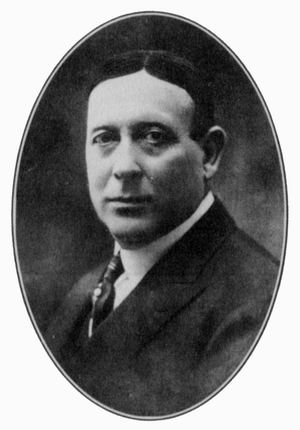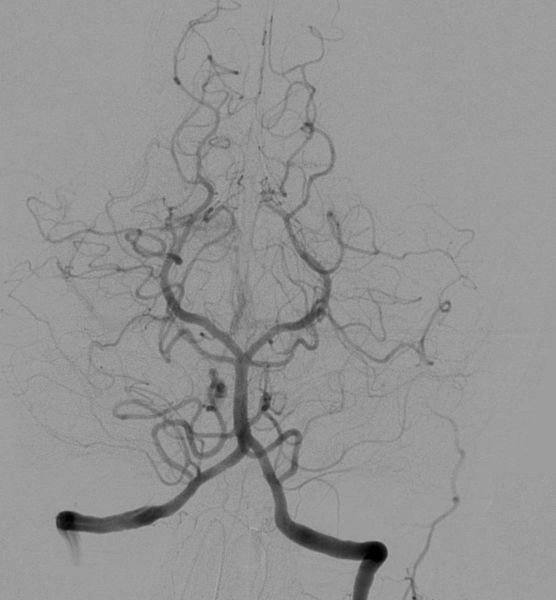Egas Moniz
From Psy3242
(→'''Cerebral Angiography''') |
|||
| (10 intermediate revisions not shown) | |||
| Line 1: | Line 1: | ||
[[Category:Neuropsychological profiles]] | [[Category:Neuropsychological profiles]] | ||
| - | '''Egas Moniz''' | + | == '''Egas Moniz''' == |
| + | [[Image:Egas.JPG]] | ||
| - | |||
| - | + | == '''Biographical Information''' == | |
| + | ---- | ||
| - | ''' | + | Born in Portugal in 1874, this '''Egas Moniz''' was a Portuguese neuropsychologist. Moniz studied medicine at the Coimbra University, as well as neurology in Paris. He was a professor and faculty member at Coimbra University, and later became the Chair of Neurology in Lisbon. While in Lisbon he worked at Hospital of Santa Maria as a physician. Moniz was most famous for his development of the '''prefrontal leucotomy''' and '''cerebral angiography'''. Moniz had many famous publications in a variety of fields, including neuropsychology, physiology, and politics. He was the first Portuguese to receive a Nobel Prize, which he earned in 1949 because of his contributions to the field. He died in 1955. |
| - | |||
| - | ''' | + | == '''Prefrontal Leucotomy''' == |
| + | ---- | ||
| + | The procedure, prefrontal leucotomy, was later adopted and simplified by [[Walter Freeman]] who renamed it the "lobotomy" as a leucotome (a retractable blade) was no longer used in the modified procedure. Following a previously study done on the removal of frontal lobes in chimpanzees resulting in the exhibition of tame behavior, Moniz became intrigued and wondered what the results of similar work would be in humans with severe mental illness. He reportedly thought that mental illnesses were caused by certain nerve cell connections. In order to treat these mental disorders, including those with depression and psychosis, he performed his first surgery in 1935 to severe nerve fibers in the frontal lobe. After 20 successful surgeries, his work was published and it was deemed a success because of the patient's positive effects in terms of treating their mental illness. More currently there is a greater knowledge about this area in the brain and its implications, and it is now known that a surgery of this kind may have more devastating drawbacks. Many executive functions are compromised, and it is often thought better to treat the mental illness in other ways to avoid the effects on executive functioning. Because of the growing field of pharmaceuticals, chemical drugs more commonly treat such disorders. | ||
| - | |||
| - | Aside from his impressive career contributing to the field of neuropsychology, Moniz became interested in politics. He served many roles in this aspects of his life, including spending time as the Deputy of | + | |
| + | [[Image: leuc.jpg]] | ||
| + | |||
| + | (A patient being prepared for a leucotomy) | ||
| + | |||
| + | |||
| + | [[Image: 200px-Leucotomy.jpg]] | ||
| + | |||
| + | This image shows a brain after a leucotomy has been performed. The dark sections in the middle of the two halves are areas where the frontal lobes have been removed. | ||
| + | |||
| + | == '''Cerebral Angiography''' == | ||
| + | |||
| + | ---- | ||
| + | |||
| + | Moniz aided in developing the '''cerebral angiography''' in 1927. This procedure allows for dye to be injected into arteries in the neck, called the caretoid arteries, by placing a catheter into the body, usually the thigh. This leads the dye to the neck arteries which will allow the dye to enter the brain. Then an x-ray is taken of the brain to see the dye since it acts as a contrasting medium. It will allow doctors to see any abnormalities within the blood vessels in the brain. This procedure generally only takes place after an initial abnormality is recognized. | ||
| + | |||
| + | |||
| + | [[Image: angiography.JPG]] | ||
| + | |||
| + | This image shows what would appear on the x-ray image. The dark area is the dye which allows for blood vessels within the brain to be seen. | ||
| + | |||
| + | == '''Publications''' == | ||
| + | |||
| + | ---- | ||
| + | |||
| + | Some of his publications, written mostly in Portuguese, are included below. | ||
| + | |||
| + | |||
| + | |||
| + | A neurologia na guerra (Neurology in war), Lisbon, 1917. | ||
| + | |||
| + | Diagnostic des tumeurs cérébrales et épreuve de l'encéphalographie artérielle (Diagnostics of cerebral tumours and application of arterial encephalography), Paris, 1931. | ||
| + | |||
| + | L'angiographie cérébrale, ses applications et résultats en anatomic, physiologie te clinique (Cerebral angiography, its applications and results in anatomy, physiology, and clinic), Paris, 1934. | ||
| + | |||
| + | Tentatives opératoires dans le traitement de certaines psychoses (Tentative methods in the treatment of certain psychoses), Paris, 1936. | ||
| + | |||
| + | La leucotomie préfrontale. Traitement chirurgical de certaines psychoses (Prefrontal leucotomy. Surgical treatment of certain psychoses), Turin, 1937. | ||
| + | |||
| + | Clinica dell'angiografia cerebrale (Clinical cerebral angiography), Turin, 1938. | ||
| + | |||
| + | Ao lado da medicina (On the side of medicine), Lisbon, 1940. | ||
| + | |||
| + | Como cheguei a realizar a leucotomia pré-frontal (How I came to perform leucotomy), Lisbon, 1948. | ||
| + | |||
| + | Die präfrontale Leukotomie (Prefrontal leucotomy), 1949. | ||
| + | |||
| + | == '''Interesting Facts''' == | ||
| + | |||
| + | ---- | ||
| + | |||
| + | |||
| + | Aside from his impressive career contributing to the field of neuropsychology, Moniz became interested in politics. He served many roles in this aspects of his life, including spending time as the Deputy of Portuguese Parliament, Portuguese Ambassador to Spain, Minister of Foreign Affairs, and President of the Portuguese Delegation at the Paris Peace Conference in 1918. | ||
Current revision as of 05:27, 28 April 2008
Contents |
Egas Moniz
Biographical Information
Born in Portugal in 1874, this Egas Moniz was a Portuguese neuropsychologist. Moniz studied medicine at the Coimbra University, as well as neurology in Paris. He was a professor and faculty member at Coimbra University, and later became the Chair of Neurology in Lisbon. While in Lisbon he worked at Hospital of Santa Maria as a physician. Moniz was most famous for his development of the prefrontal leucotomy and cerebral angiography. Moniz had many famous publications in a variety of fields, including neuropsychology, physiology, and politics. He was the first Portuguese to receive a Nobel Prize, which he earned in 1949 because of his contributions to the field. He died in 1955.
Prefrontal Leucotomy
The procedure, prefrontal leucotomy, was later adopted and simplified by Walter Freeman who renamed it the "lobotomy" as a leucotome (a retractable blade) was no longer used in the modified procedure. Following a previously study done on the removal of frontal lobes in chimpanzees resulting in the exhibition of tame behavior, Moniz became intrigued and wondered what the results of similar work would be in humans with severe mental illness. He reportedly thought that mental illnesses were caused by certain nerve cell connections. In order to treat these mental disorders, including those with depression and psychosis, he performed his first surgery in 1935 to severe nerve fibers in the frontal lobe. After 20 successful surgeries, his work was published and it was deemed a success because of the patient's positive effects in terms of treating their mental illness. More currently there is a greater knowledge about this area in the brain and its implications, and it is now known that a surgery of this kind may have more devastating drawbacks. Many executive functions are compromised, and it is often thought better to treat the mental illness in other ways to avoid the effects on executive functioning. Because of the growing field of pharmaceuticals, chemical drugs more commonly treat such disorders.
(A patient being prepared for a leucotomy)
This image shows a brain after a leucotomy has been performed. The dark sections in the middle of the two halves are areas where the frontal lobes have been removed.
Cerebral Angiography
Moniz aided in developing the cerebral angiography in 1927. This procedure allows for dye to be injected into arteries in the neck, called the caretoid arteries, by placing a catheter into the body, usually the thigh. This leads the dye to the neck arteries which will allow the dye to enter the brain. Then an x-ray is taken of the brain to see the dye since it acts as a contrasting medium. It will allow doctors to see any abnormalities within the blood vessels in the brain. This procedure generally only takes place after an initial abnormality is recognized.
This image shows what would appear on the x-ray image. The dark area is the dye which allows for blood vessels within the brain to be seen.
Publications
Some of his publications, written mostly in Portuguese, are included below.
A neurologia na guerra (Neurology in war), Lisbon, 1917.
Diagnostic des tumeurs cérébrales et épreuve de l'encéphalographie artérielle (Diagnostics of cerebral tumours and application of arterial encephalography), Paris, 1931.
L'angiographie cérébrale, ses applications et résultats en anatomic, physiologie te clinique (Cerebral angiography, its applications and results in anatomy, physiology, and clinic), Paris, 1934.
Tentatives opératoires dans le traitement de certaines psychoses (Tentative methods in the treatment of certain psychoses), Paris, 1936.
La leucotomie préfrontale. Traitement chirurgical de certaines psychoses (Prefrontal leucotomy. Surgical treatment of certain psychoses), Turin, 1937.
Clinica dell'angiografia cerebrale (Clinical cerebral angiography), Turin, 1938.
Ao lado da medicina (On the side of medicine), Lisbon, 1940.
Como cheguei a realizar a leucotomia pré-frontal (How I came to perform leucotomy), Lisbon, 1948.
Die präfrontale Leukotomie (Prefrontal leucotomy), 1949.
Interesting Facts
Aside from his impressive career contributing to the field of neuropsychology, Moniz became interested in politics. He served many roles in this aspects of his life, including spending time as the Deputy of Portuguese Parliament, Portuguese Ambassador to Spain, Minister of Foreign Affairs, and President of the Portuguese Delegation at the Paris Peace Conference in 1918.




